The first time I saw a dress like this—one that felt both ancient and utterly modern—I was standing in the back row of Paris Fashion Week, watching a model glide down the runway in a sculpted silk column. That moment was 2023. Now, with Emily Blunt’s appearance at the Smashing Machine premiere during the 82nd Venice International Film Festival on September 1, 2025, Hollywood has officially embraced it: the return of the couture column gown, reimagined for a new era of refined power dressing.
She didn’t just walk the red carpet—she commanded it.
In a sea of bold silhouettes and experimental textures, Blunt chose restraint, precision, and luminous grace. Her Tamara Ralph Fall 2025 Couture Gown—a strapless, floor-length number in a soft rose-gold hue—wasn’t flashy. It was architectural. The fabric, a densely woven metallic mesh, caught the light like liquid mercury, creating an almost holographic effect under the Venetian evening sky. But what truly elevated it was the drape—a single, dramatic fold cascading from the waist, mimicking the folds of classical drapery yet rendered with modern tailoring. It wasn’t just a gown; it was a statement about form, femininity, and quiet strength.
And then there were the details—the ones that only a true fashion insider would notice. The Tiffany & Co. Ray of Light Earrings, set with diamonds and pink sapphires, weren’t just accessories. They were conversation starters. Their geometric design—sharp, radiant, almost futuristic—played beautifully against the organic flow of the gown, creating a tension between nature and technology, past and future. Paired with the matching Ray of Light Ring, the look became a wearable piece of art. It was jewelry as punctuation, not ornamentation.
Her hair? A sleek half-up, half-down style with soft waves framing her face—classic, yes, but with a contemporary twist. Not too polished, not too undone. Just enough to let the gown speak. And the makeup? A bold, crimson lip—that color—perfectly balanced by a dewy complexion and sharp eyeliner. It wasn’t overdone. It was intentional. Every element served the whole.
This isn’t just a red carpet look. It’s a cultural moment.
When you see a star like Blunt—someone who has long been associated with sophistication and intelligence—opt for such a deliberate, almost ceremonial aesthetic, it sends a message: glamour is back. But not the kind of glamour we saw in the 2010s, when sparkle meant volume and noise. This is quiet luxury, filtered through a lens of heritage craftsmanship. Think of Grace Kelly in 1954, or Audrey Hepburn at Cannes in 1961—elegance defined by restraint, not excess.
And yet, it’s undeniably modern. The Tamara Ralph collection, presented in Paris earlier that month, was built around the idea of “emotional architecture”—clothing that responds to the body’s movement, that breathes with the wearer. Blunt embodied that philosophy. The gown hugged her frame without constriction, flowing into a train that whispered across the red carpet like a secret.
I’ve seen many gowns at Venice—some breathtaking, some baffling—but few have struck me with such clarity. This one felt right. It wasn’t trying to be the most dramatic. It wasn’t chasing trends. It was simply… perfect.
As fashion critic Luca Vittorio once said backstage at Milan Fashion Week: “True style isn’t about being seen—it’s about being remembered.” Blunt’s look will be remembered. Not because it was loud, but because it was true.
And that, my dear readers, is the difference between fashion and legacy.
5 Elements That Made Emily Blunt’s Venice Look Iconic
- The Dress: A Tamara Ralph Fall 2025 Couture Gown in rose-gold metallic mesh—structured yet fluid, modern yet timeless.
- The Jewelry: Tiffany & Co. Ray of Light earrings and ring—geometric brilliance that complemented the gown’s architectural lines.
- The Silhouette: A strapless column with a single draped fold—minimalist drama at its finest.
- The Hair & Makeup: Soft waves pulled back, bold red lip, dewy skin—effortlessly elegant.
- The Attitude: Confidence without arrogance. Poise without pretension. She wasn’t posing—she was present.
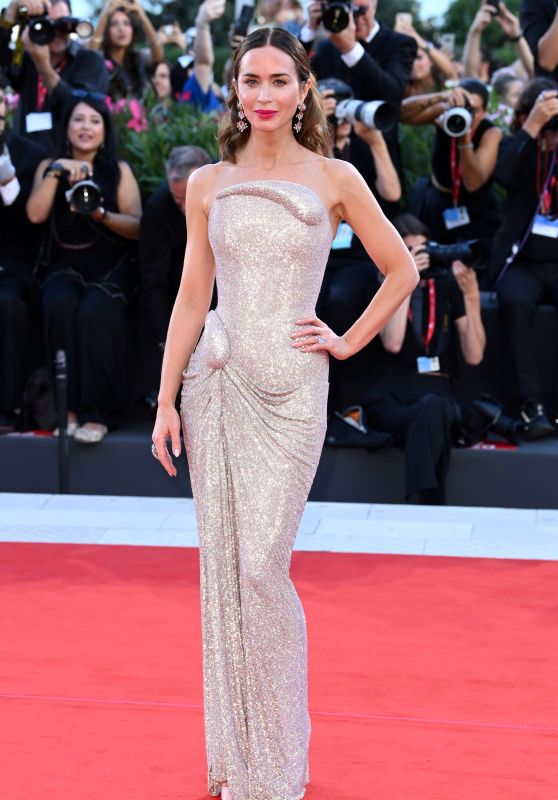



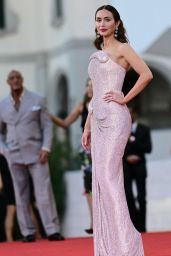

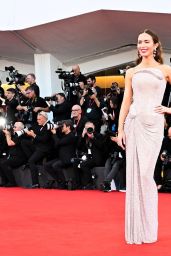



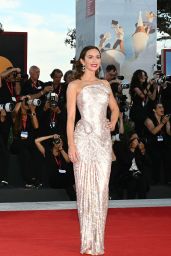
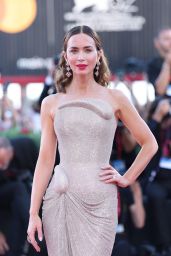


Share what you think